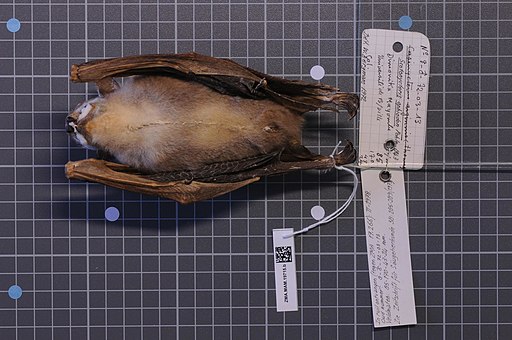Superregnum: Eukaryota
Regnum: Animalia
Subregnum: Eumetazoa
Cladus: Bilateria
Cladus: Nephrozoa
Superphylum: Deuterostomia
Phylum: Chordata
Cladus: Craniata
Subphylum: Vertebrata
Infraphylum: Gnathostomata
Superclassis: Tetrapoda
Cladus: Reptiliomorpha
Cladus: Amniota
Cladus: Synapsida
Cladus: Eupelycosauria
Cladus: Sphenacodontia
Cladus: Sphenacodontoidea
Ordo: Therapsida
Cladus: Theriodontia
Subordo: Cynodontia
Cladus: Mammaliaformes
Classis: Mammalia
Subclassis: Trechnotheria
Infraclassis: Zatheria
Supercohort: Theria
Cohort: Eutheria
Cohort: Placentalia
Cladus: Boreoeutheria
Superordo: Laurasiatheria
Ordo: Chiroptera
Subordo: Yinpterochiroptera
Familia: Pteropodidae
Subfamilia: Pteropodinae
Tribus: Epomophorini
Genus: Scotonycteris
Species: Scotonycteris ophiodon
Name
Scotonycteris ophiodon Pohle, 1943
Type locality: Cameroon, Bipindi.
Synonyms
cansdalei Hayman, 1946
References
Pohle. 1943 Sitzb. Ges. Naturf. Fr. Berlin: 76.
Distribution
Liberia
Ghana
Cameroon
Republic of Congo
Vernacular names
English: Pohle's Fruit Bat
Pohle's fruit bat (Casinycteris ophiodon) is a near threatened species of megabat found in the subtropical or tropical forests of Cameroon, the Republic of Congo, Côte d'Ivoire, Ghana and Liberia.[1]
Taxonomy
In 2014, its taxonomy was revised. While it was previously in the genus Scotonycteris, analysis of mitochondrial DNA showed that it should be placed in Casinycteris to avoid paraphyly of Scotonycteris.[2]
Description
These bats are also known as 'tear-drop' fruit bats because of the prominent tear-like white spots found on both sides of their eyes and on their upper lips. Their fur is tinted and the wings are dark brown. They measure 74-78 millimeters and weigh between 35 and 60 grams.[3]
Ecology
These bats live in the lowland forests of West and Central Africa, mostly in the lowest level of undergrowth, where they feed on various fruits and flowers.
Conservation
The main threats to this species' habitat include agriculture, mining, logging, and human disturbances such as fire. There are established policy based legislation actions as well as habitat and site-based action in protected areas.
References
Mickleburgh, S.; Hutson, A.M.; Bergmans, W.; Fahr, J.; Juste, J. (2010). "Scotonycteris ophiodon". The IUCN Red List of Threatened Species. 2010: e.T20059A9140239. doi:10.2305/IUCN.UK.2010-2.RLTS.T20059A9140239.en.
Hassanin, A. (2014). Description of a new bat species of the tribe Scotonycterini (Chiroptera, Pteropodidae) from southwestern Cameroon. Comptes Rendus Biologies, 337(2), 134-142.
Kingdon, Jonathan. The Kingdon Field Guide to African Mammals. California: Academic Press, 1997.
Retrieved from "http://en.wikipedia.org/"
All text is available under the terms of the GNU Free Documentation License


